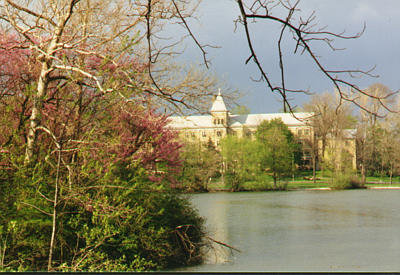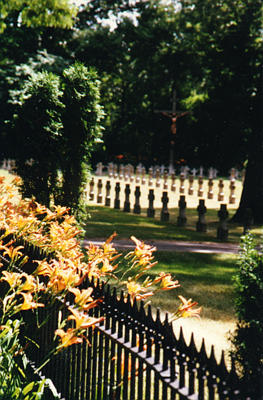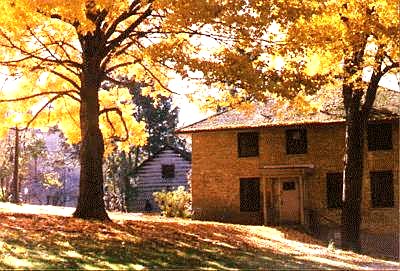
Notre Dame's Grotto / by Dorothy V. Corson


St. Mary's Island
The first space on the site dedicated to Our Lady was the island in the already named St. Mary's Lake. St. Mary's Island was the first of many honors bestowed upon Mary leading up to the present Grotto -- now a favorite retreat on campus. Columba Hall, a later building on the island, is pictured above.
Two years after Sorin's arrival in 1844, the first chapel, which adjoined the Novitiate, was built on the island:
The Community Cemetery
This first winter at Notre Dame turned out to be a very severe one. It seems to have been during this time that Sister Mary of Calvary fell ill, perhaps from living in that drafty log cabin loft; perhaps she had not entirely recovered from the fatigue of the journey from France. She was pronounced dying and received the last sacraments to the great distress of all. Father Sorin, in fact, made a vow that if Sister Calvary recovered, a chapel would be built on the island in the middle of St. Mary's Lake. With that, Sister Calvary did indeed begin to recover, and when the chapel was built in the spring she had the honor of laying the first stone.(12)

This Island is necessarily dear to the Order of the Holy Cross; it was the first spot dedicated to Mary and the association of years have added greatly to this endearment. Nearly all the American Brothers look to this spot as their Alma Mater, and here repose the bodies of nearly all who have been called by their Heavenly Father from their work below, to their reward above. Long rows of black crosses continually remind the living associates how their brethren gone before are awaiting them.
This tender affection for this lovely spot has led to its adornment beyond any other portion of the premises.(13)
The little Chapel on the "Island," dedicated to Our Lady of the Lake, was blessed on the 8th of December 1844 and named Most Holy and Immaculate Heart of Mary Chapel. Visitors paddled to the chapel in canoes from the shore of the lake because the neck of land was marshland in the early years:
A quaint octagonal Chapel, modest and retired, where the whole community of Notre Dame assembled in times of joy to thank God, and in times of sadness and grief to beg his aid. In 1847, on the 19th of March, it was enriched with the precious body of St. Severa, virgin and martyr, (of the third century) given to the Chapel by Bishop Hailandiere, on his return from Rome in 1845. . . . In this chapel, the Archbishop -- then Bishop -- of Cincinnati, the Bishops of Milwaukee and Detroit, said Mass with evident delight.
Mrs. Byerley furnished it with a beautiful carpet and Bro. Francis Xavier taxed his taste and skill to the uttermost to adorn the sanctuary. It moves even such cold hearts as ours to listen to good Brother Vincent and other of the more ancient Brothers recount the glories of that dear little Chapel. It is now of the past -- but not forgotten. The Chapel of the Portiuncula, with its many privileges, has supplanted it on the "Island." . . . All those who ever had the privilege of praying in the dear secluded sanctuary, remember it with affectionate regret.(14)

Like many early buildings on the campus this chapel has not survived (the oldest building presently on campus is Old College, pictured above, built in 1843.) The replica and bones of the precious body of St. Severa, virgin and martyr, a young girl who was brutally slain in the Roman persecutions because she kept the faith is one of the oldest antiquities at Notre Dame. Her bones and the replica of her body now repose in a glass case among other relics in the Reliquary Chapel of the Basilica of the Sacred Heart.
Other later "adornments" to the Island included the Tomb of Blessed Virgin Mary, and the Holy Sepulcher, which measured eight feet high, fifteen feet long, and six feet wide.